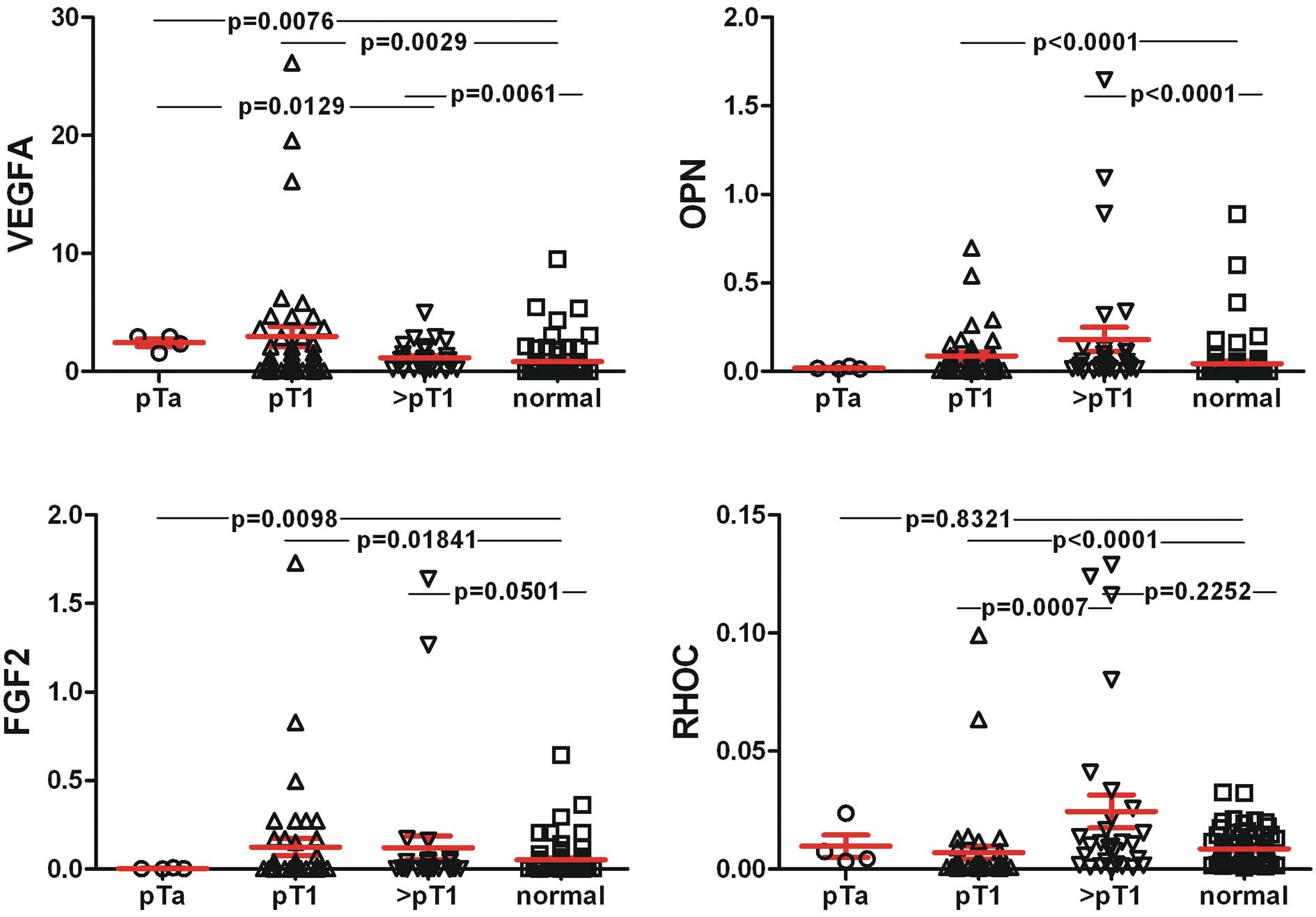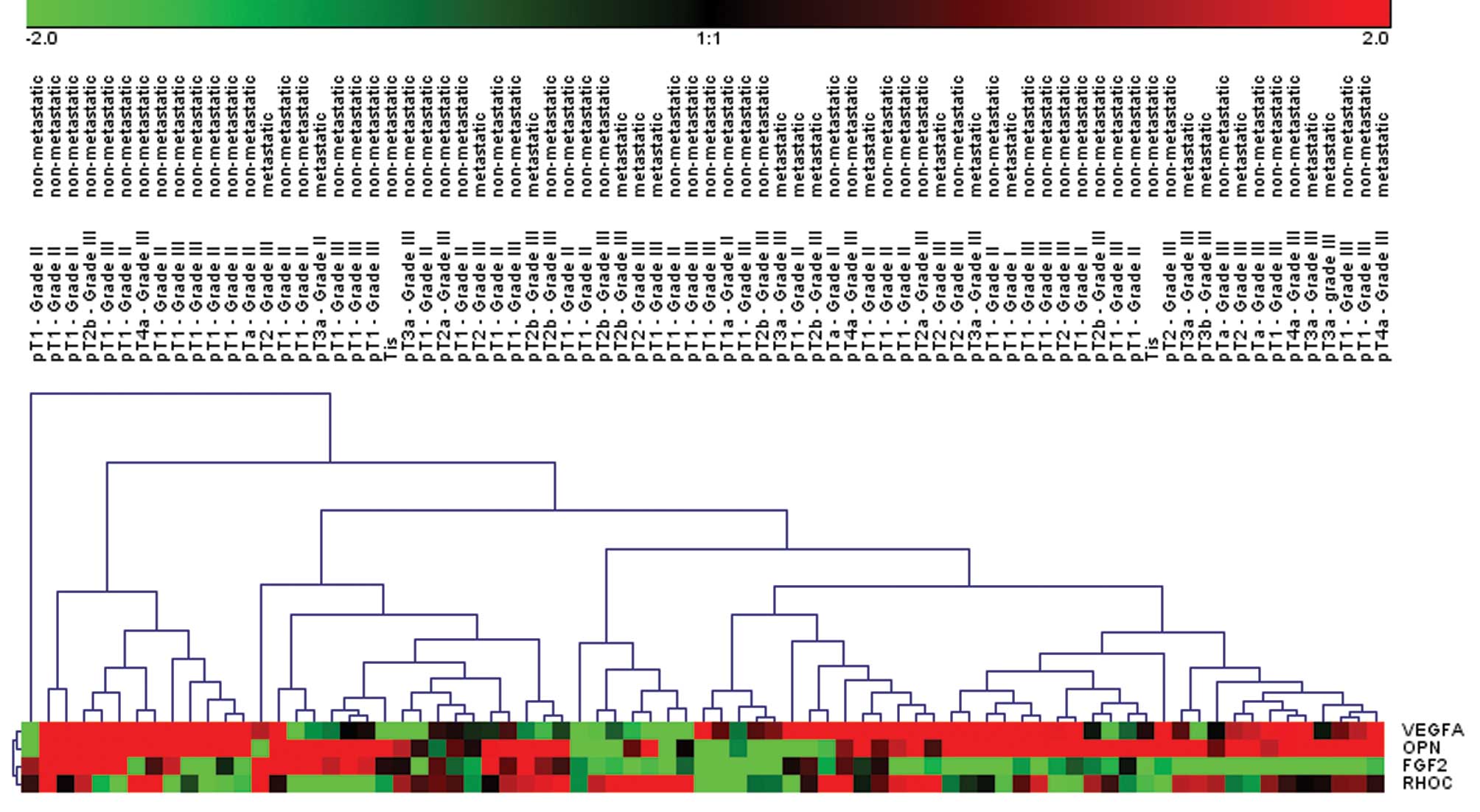|
1
|
Folkman J and Shing Y: Angiogenesis. J
Biol Chem. 267:10931–10934. 1992.
|
|
2
|
Jayet C, Deperthes D and Leisinger HJ:
Angiogenesis and bladder cancer: trendy prognostic factor or new
therapeutic target? Ann Urol (Paris). 36:258–263. 2002.(Article in
French).
|
|
3
|
Bochner BH, Cote RJ, Weidner N, et al:
Angiogenesis in bladder cancer: relationship between microvessel
density and tumor prognosis. J Natl Cancer Inst. 87:1603–1612.
1995. View Article : Google Scholar : PubMed/NCBI
|
|
4
|
Donmez G, Sullu Y, Baris S, et al:
Vascular endothelial growth factor (VEGF), matrix
metalloproteinase-9 (MMP-9), and thrombospondin-1 (TSP-1)
expression in urothelial carcinomas. Pathol Res Pract. 205:854–857.
2009. View Article : Google Scholar : PubMed/NCBI
|
|
5
|
Pignot G, Bieche I, Vacher S, et al:
Large-scale real-time reverse transcription-PCR approach of
angiogenic pathways in human transitional cell carcinoma of the
bladder: identification of VEGFA as a major independent prognostic
marker. Eur Urol. 56:678–688. 2009. View Article : Google Scholar
|
|
6
|
Chikazawa M, Inoue K, Fukata S, Karashima
T and Shuin T: Expression of angiogenesis-related genes regulates
different steps in the process of tumor growth and metastasis in
human urothelial cell carcinoma of the urinary bladder.
Pathobiology. 75:335–345. 2008. View Article : Google Scholar : PubMed/NCBI
|
|
7
|
El-Tanani MK: Role of osteopontin in
cellular signaling and metastatic phenotype. Front Biosci.
13:4276–4284. 2008. View
Article : Google Scholar : PubMed/NCBI
|
|
8
|
Rittling SR and Chambers AF: Role of
osteopontin in tumour progression. Br J Cancer. 90:1877–1881. 2004.
View Article : Google Scholar : PubMed/NCBI
|
|
9
|
Ang C, Chambers AF, Tuck AB, Winquist E
and Izawa JI: Plasma osteopontin levels are predictive of disease
stage in patients with transitional cell carcinoma of the bladder.
BJU Int. 96:803–805. 2005. View Article : Google Scholar : PubMed/NCBI
|
|
10
|
Zaravinos A, Lambrou GI, Volanis D,
Delakas D and Spandidos DA: Spotlight on differentially expressed
genes in urinary bladder cancer. PloS One. 6:e182552011. View Article : Google Scholar : PubMed/NCBI
|
|
11
|
Wang W, Wu F, Fang F, Tao Y and Yang L:
RhoC is essential for angiogenesis induced by hepatocellular
carcinoma cells via regulation of endothelial cell organization.
Cancer Sci. 99:2012–2018. 2008.PubMed/NCBI
|
|
12
|
Fritz G, Just I and Kaina B: Rho GTPases
are over-expressed in human tumors. Int J Cancer. 81:682–687. 1999.
View Article : Google Scholar : PubMed/NCBI
|
|
13
|
Kamai T, Tsujii T, Arai K, et al:
Significant association of Rho/ROCK pathway with invasion and
metastasis of bladder cancer. Clin Cancer Res. 9:2632–2641.
2003.PubMed/NCBI
|
|
14
|
Volanis D, Zaravinos A, Kadiyska T,
Delakas D, Zoumpourlis V and Spandidos DA: Expression profile of
Rho kinases in urinary bladder cancer. J BUON. 16:511–521.
2011.PubMed/NCBI
|
|
15
|
Zaravinos A, Chatziioannou M, Lambrou GI,
Boulalas I, Delakas D and Spandidos DA: Implication of RAF and RKIP
genes in urinary bladder cancer. Pathol Oncol Res. 17:181–190.
2011. View Article : Google Scholar : PubMed/NCBI
|
|
16
|
Boulalas I, Zaravinos A, Delakas D and
Spandidos DA: Mutational analysis of the BRAF gene in transitional
cell carcinoma of the bladder. Int J Biol Markers. 24:17–21.
2009.PubMed/NCBI
|
|
17
|
Zaravinos A, Lambrou GI, Boulalas I,
Delakas D and Spandidos DA: Identification of common differentially
expressed genes in urinary bladder cancer. PloS One. 6:e181352011.
View Article : Google Scholar : PubMed/NCBI
|
|
18
|
Folkman J: Angiogenesis in cancer,
vascular, rheumatoid and other disease. Nat Med. 1:27–31. 1995.
View Article : Google Scholar : PubMed/NCBI
|
|
19
|
Ke HL, Chang LL, Yang SF, et al:
Osteopontin overexpression predicts poor prognosis of upper urinary
tract urothelial carcinoma. Urol Oncol. 29:703–709. 2011.
View Article : Google Scholar : PubMed/NCBI
|
|
20
|
Inoue K, Slaton JW, Karashima T, et al:
The prognostic value of angiogenesis factor expression for
predicting recurrence and metastasis of bladder cancer after
neoadjuvant chemotherapy and radical cystectomy. Clin Cancer Res.
6:4866–4873. 2000.
|
|
21
|
Yang S, Wu X, Luo C, Pan C and Pu J:
Expression and clinical significance of hepaCAM and VEGF in
urothelial carcinoma. World J Urol. 28:473–478. 2010. View Article : Google Scholar : PubMed/NCBI
|
|
22
|
Shariat SF, Youssef RF, Gupta A, et al:
Association of angiogenesis related markers with bladder cancer
outcomes and other molecular markers. J Urol. 183:1744–1750. 2010.
View Article : Google Scholar : PubMed/NCBI
|
|
23
|
Zachos I, Konstantinopoulos PA, Tzortzis
V, et al: Systemic therapy of metastatic bladder cancer in the
molecular era: current status and future promise. Expert Opin
Investig Drugs. 19:875–887. 2010. View Article : Google Scholar : PubMed/NCBI
|
|
24
|
Chakraborty G, Jain S and Kundu GC:
Osteopontin promotes vascular endothelial growth factor-dependent
breast tumor growth and angiogenesis via autocrine and paracrine
mechanisms. Cancer Res. 68:152–161. 2008. View Article : Google Scholar
|
|
25
|
Marzioni D, Lorenzi T, Mazzucchelli R, et
al: Expression of basic fibroblast growth factor, its receptors and
syndecans in bladder cancer. Int J Immunopathol Pharmacol.
22:627–638. 2009.PubMed/NCBI
|
|
26
|
Gan Y, Wientjes MG and Au JL: Expression
of basic fibroblast growth factor correlates with resistance to
paclitaxel in human patient tumors. Pharm Res. 23:1324–1331. 2006.
View Article : Google Scholar : PubMed/NCBI
|
|
27
|
Gravas S, Bosinakou I, Kehayas P and
Giannopoulos A: Urinary basic fibroblast growth factor in bladder
cancer patients. Histopathological correlation and clinical
potential. Urol Int. 73:173–177. 2004. View Article : Google Scholar
|
|
28
|
Stoletov K, Montel V, Lester RD, Gonias SL
and Klemke R: High-resolution imaging of the dynamic tumor cell
vascular interface in transparent zebrafish. Proc Natl Acad Sci
USA. 104:17406–17411. 2007. View Article : Google Scholar : PubMed/NCBI
|
|
29
|
Abe H, Kamai T, Tsujii T, et al: Possible
role of the RhoC/ROCK pathway in progression of clear cell renal
cell carcinoma. Biomed Res. 29:155–161. 2008. View Article : Google Scholar : PubMed/NCBI
|
|
30
|
Horiuchi A, Imai T, Wang C, et al:
Up-regulation of small GTPases, RhoA and RhoC, is associated with
tumor progression in ovarian carcinoma. Lab Invest. 83:861–870.
2003. View Article : Google Scholar : PubMed/NCBI
|


















